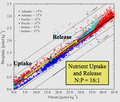Phosphate: Difference between revisions
CSV import |
No edit summary |
||
| Line 1: | Line 1: | ||
{{Short description|Overview of phosphate use in biological systems and industry}} | {{Short description|Overview of phosphate use in biological systems and industry}} | ||
[[File:3-phosphoric-acid-3D-balls.png|thumb|Phosphoric acid molecule]] | [[File:3-phosphoric-acid-3D-balls.png|thumb|Phosphoric acid molecule]] | ||
[[File:2-dihydrogenphosphate-3D-balls.png|thumb|Dihydrogen phosphate ion]] | [[File:2-dihydrogenphosphate-3D-balls.png|thumb|Dihydrogen phosphate ion]] | ||
[[File:1-hydrogenphosphate-3D-balls.png|thumb|Hydrogen phosphate ion]] | [[File:1-hydrogenphosphate-3D-balls.png|thumb|Hydrogen phosphate ion]] | ||
[[File:0-phosphate-3D-balls.png|thumb|Phosphate ion]] | [[File:0-phosphate-3D-balls.png|thumb|Phosphate ion]] | ||
'''Phosphate''' is an inorganic chemical and a salt of [[phosphoric acid]]. In [[organic chemistry]], a phosphate, or organophosphate, is an [[ester]] of phosphoric acid. Phosphates are essential for life, playing a critical role in [[biochemistry]] and [[ecology]]. | '''Phosphate''' is an inorganic chemical and a salt of [[phosphoric acid]]. In [[organic chemistry]], a phosphate, or organophosphate, is an [[ester]] of phosphoric acid. Phosphates are essential for life, playing a critical role in [[biochemistry]] and [[ecology]]. | ||
| Line 35: | Line 33: | ||
The excessive use of phosphate fertilizers and detergents can lead to environmental issues such as eutrophication, which is the over-enrichment of water bodies with nutrients. This can cause algal blooms, deplete oxygen levels, and harm aquatic life. | The excessive use of phosphate fertilizers and detergents can lead to environmental issues such as eutrophication, which is the over-enrichment of water bodies with nutrients. This can cause algal blooms, deplete oxygen levels, and harm aquatic life. | ||
== Images == | |||
<gallery> | |||
File:PiSpeciation.svg|Phosphate | |||
File:Phosphate Mine Panorama.jpg|Phosphate | |||
File:Train loaded with phosphate rock, Metlaoui Tunisia-4298B.jpg|Phosphate | |||
File:International Exchange of Phosphates in 1937 - DPLA - 03790fc57d3206e73683a68ec11c8fb2.jpg|Phosphate | |||
File:Annual mean sea surface phosphate (World Ocean Atlas 2009).png|Phosphate | |||
File:PhosphatetoNitrate.png|Phosphate | |||
</gallery> | |||
==Also see== | ==Also see== | ||
* [[Phosphoric acid]] | * [[Phosphoric acid]] | ||
| Line 48: | Line 55: | ||
[[Category:Biochemistry]] | [[Category:Biochemistry]] | ||
[[Category:Agricultural chemicals]] | [[Category:Agricultural chemicals]] | ||
Latest revision as of 14:19, 21 May 2025
Overview of phosphate use in biological systems and industry




Phosphate is an inorganic chemical and a salt of phosphoric acid. In organic chemistry, a phosphate, or organophosphate, is an ester of phosphoric acid. Phosphates are essential for life, playing a critical role in biochemistry and ecology.
Biological Importance[edit]
Phosphates are vital components of DNA, RNA, ATP, and phospholipids, which form all cell membranes. They are involved in energy transfer through the formation of high-energy phosphate bonds in adenosine triphosphate (ATP) and guanosine triphosphate (GTP). Phosphates also play a crucial role in cell signaling as part of phosphorylation processes.
DNA and RNA[edit]
Phosphates form the backbone of DNA and RNA molecules, linking together the nucleotides in a chain through phosphodiester bonds. This structure is essential for the stability and function of genetic material.
Energy Transfer[edit]
ATP, the primary energy carrier in cells, contains three phosphate groups. The hydrolysis of the terminal phosphate group releases energy that is used in various cellular processes, including muscle contraction, nerve impulse propagation, and biosynthesis.
Cell Signaling[edit]
Phosphorylation, the addition of a phosphate group to a protein or other organic molecule, is a common mechanism for regulating protein function and signaling pathways. This process is mediated by enzymes known as kinases and is reversed by phosphatases.
Industrial and Agricultural Use[edit]
Phosphates are widely used in agriculture as fertilizers. They are a key component of superphosphate and triple superphosphate fertilizers, which are used to enhance soil fertility and crop yield. In industry, phosphates are used in the production of detergents, food additives, and water treatment chemicals.
Fertilizers[edit]
Phosphate fertilizers are essential for modern agriculture. They provide phosphorus, a critical nutrient that plants need for growth and development. The use of phosphate fertilizers has significantly increased agricultural productivity worldwide.
Detergents[edit]
Phosphates are used in detergents to soften water and enhance cleaning efficiency. However, their use has been reduced in many countries due to environmental concerns, as phosphates can contribute to eutrophication in water bodies.
Food Additives[edit]
In the food industry, phosphates are used as leavening agents, acidity regulators, and emulsifiers. They help maintain the texture and stability of processed foods.
Environmental Impact[edit]
The excessive use of phosphate fertilizers and detergents can lead to environmental issues such as eutrophication, which is the over-enrichment of water bodies with nutrients. This can cause algal blooms, deplete oxygen levels, and harm aquatic life.
Images[edit]
-
Phosphate
-
Phosphate
-
Phosphate
-
Phosphate
-
Phosphate
-
Phosphate
Also see[edit]
| Branches of chemistry | ||||||||||
|---|---|---|---|---|---|---|---|---|---|---|
|
| Biochemistry | ||||||||||
|---|---|---|---|---|---|---|---|---|---|---|
This biochemistry related article is a stub.
|




